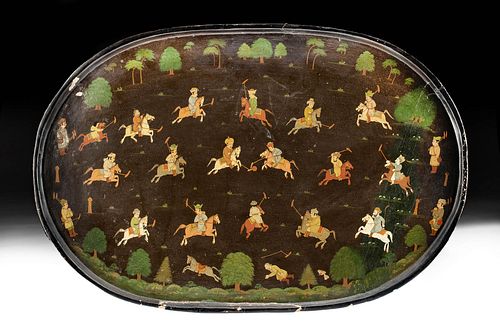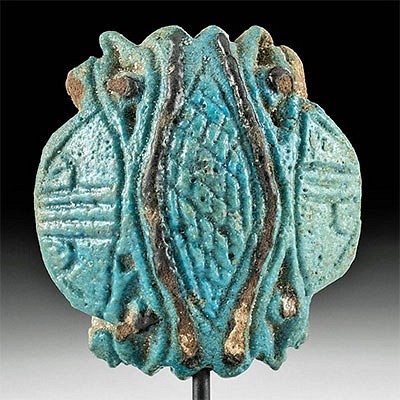19th C. Persian Lacquered Wood Tray w/ Polo Match
Lot 86
About Seller
Artemis Gallery
686 S Taylor Ave, Ste 106
Louisville, CO 80027
United States
Selling antiquities, ancient and ethnographic art online since 1993, Artemis Gallery specializes in Classical Antiquities (Egyptian, Greek, Roman, Near Eastern), Asian, Pre-Columbian, African / Tribal / Oceanographic art. Our extensive inventory includes pottery, stone, metal, wood, glass and textil...Read more
Categories
Estimate:
$700 - $1,000
Absentee vs Live bid
Two ways to bid:
- Leave a max absentee bid and the platform will bid on your behalf up to your maximum bid during the live auction.
- Bid live during the auction and your bids will be submitted real-time to the auctioneer.
Bid Increments
| Price | Bid Increment |
|---|---|
| $0 | $25 |
| $300 | $50 |
| $1,000 | $100 |
| $2,000 | $250 |
| $5,000 | $500 |
| $10,000 | $1,000 |
| $20,000 | $2,500 |
| $50,000 | $5,000 |
| $100,000 | $10,000 |
| $200,000 | $20,000 |
About Auction
By Artemis Gallery
May 27, 2021
Set Reminder
2021-05-27 10:00:00
2021-05-27 10:00:00
America/New_York
Bidsquare
Bidsquare : CLEARANCE | Antiquities & Ethnographic Art
https://www.bidsquare.com/auctions/artemis-gallery/clearance-antiquities-ethnographic-art-7010
Featuring discounted pricing and many new items! Asian art, Classical antiquities from Egypt, Greece, Italy, and the Near East...plus Pre-Columbian, Tribal, Russian Icons & Enamelware, Spanish Colonial, Fine Art, more! Some starting prices have been reduced up to 65% from original auction prices! Artemis Gallery info@artemisgallery.com
Featuring discounted pricing and many new items! Asian art, Classical antiquities from Egypt, Greece, Italy, and the Near East...plus Pre-Columbian, Tribal, Russian Icons & Enamelware, Spanish Colonial, Fine Art, more! Some starting prices have been reduced up to 65% from original auction prices! Artemis Gallery info@artemisgallery.com
- Lot Description
**Originally Listed At $400**
Central Asia, India/Persia, ca. 19th century CE. A wonderful wooden and lacquered tray featuring a polo match! The tray is a large ovoid shape with a low rim. The ground is painted black with a border of trees and foliage. At the center two teams are engaged in the mounted polo match. The courtiers are brightly garbed with crowned hats and turbans. The central figures are wrestling for the ball with their mallets. On the lower border one rider has fallen off his horse - note his broken mallet and discarded hat as his horse gallops away! A captivating piece with great attention to details. Size: 24.675" L x 16.25" W x .75" H (62.7 cm x 41.3 cm x 1.9 cm)
The text of "Karmamak-i-Ardishi-i-Papakanone" includes one of the earliest references to polo in Persia (Iran) where it was known as chaugan (meaning mallet). This text also states that Ardashir, the founder of Sassanian dynasty, was quite skilled at the sport. What's more, in India the first Mughal emperor Zahir ud-din Babur established chaugan as a popular sport at the Mughal court. In addition, during the 1560s, the Mughal Emperor Jalal ud-din Akbar, who was famous for having gold and silver knobs at the end of his mallet, introduced a set of rules and cleverly invented an illuminated ball for playing at night.
Provenance: private Evergreen, Colorado, USA collection; ex-private Denver, Colorado, USA, collection; acquired 1960 to 2000
All items legal to buy/sell under U.S. Statute covering cultural patrimony Code 2600, CHAPTER 14, and are guaranteed to be as described or your money back.
A Certificate of Authenticity will accompany all winning bids.
We ship worldwide and handle all shipping in-house for your convenience.
#163155Repaired with restoration. Large section of the rim reattached with visible break line and infill along the fissure. A wide vertical band from rim to rim on the left side has been restored with overpainting to the motif. Abrasion and cracking to rim. Chipping and flaking of paint to all sides. Verso has two large areas of paint loss. Motif is well preserved and vibrant.Condition
- Shipping Info
-
All shipping is handled in-house for your convenience. Your invoice from Artemis Gallery will include shipping calculation instructions. If in doubt, please inquire BEFORE bidding for estimated shipping costs for individual items.
-
- Buyer's Premium



 EUR
EUR CAD
CAD AUD
AUD GBP
GBP MXN
MXN HKD
HKD CNY
CNY MYR
MYR SEK
SEK SGD
SGD CHF
CHF THB
THB













